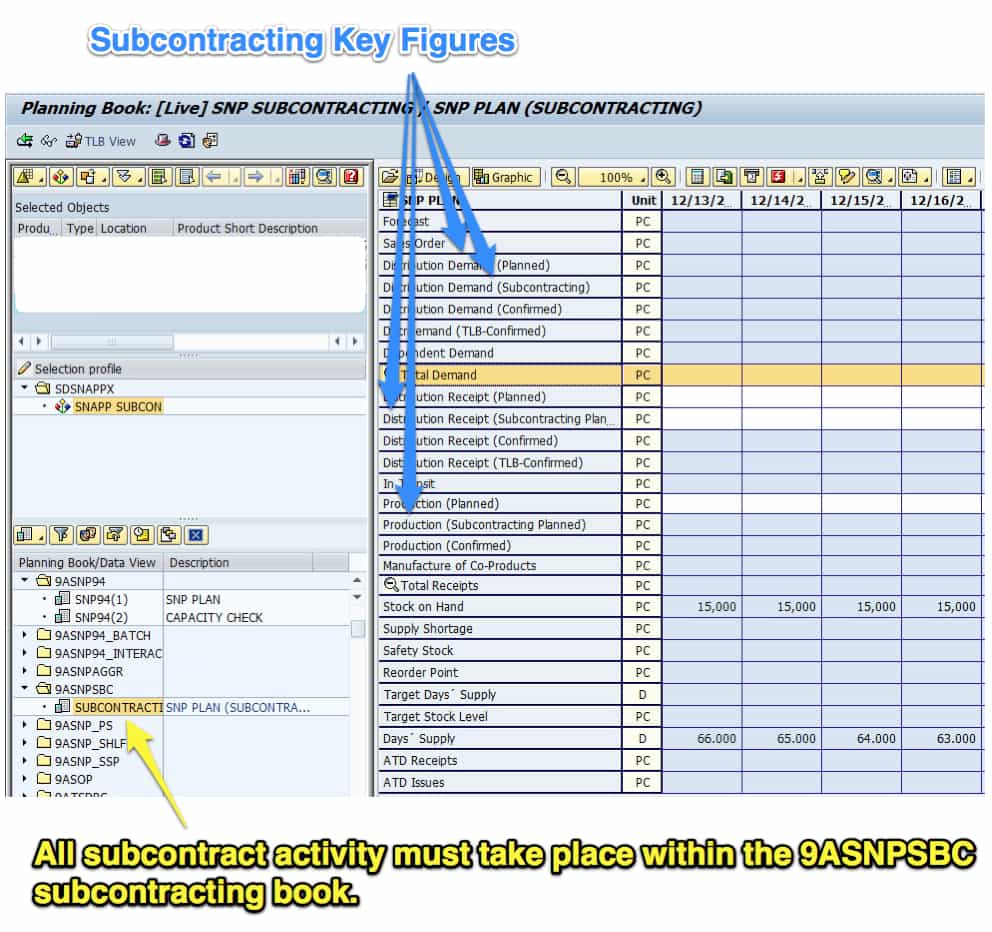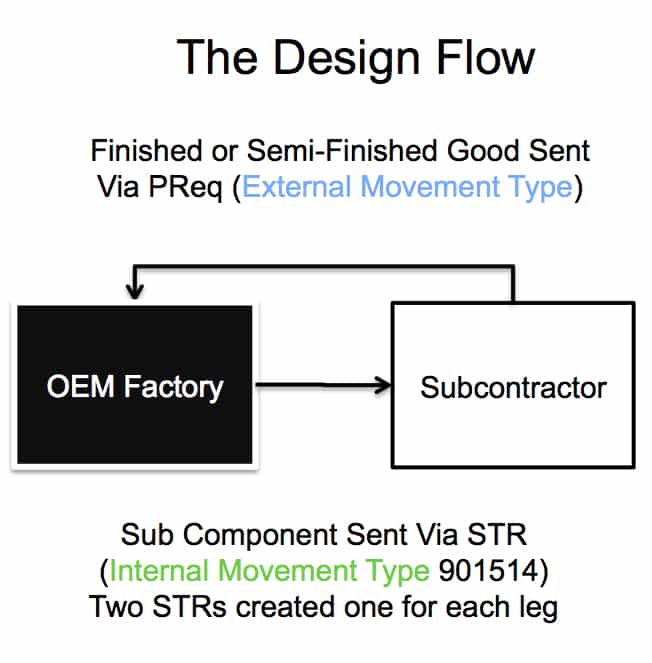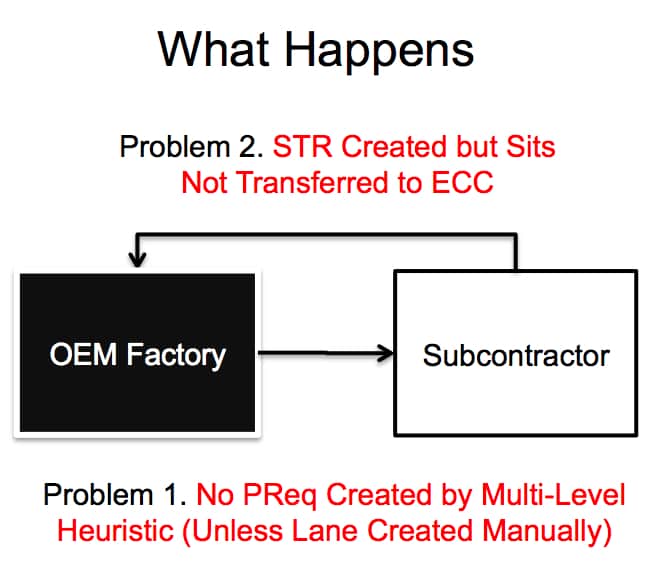How to Use SubContracting in SAP APO
Executive Summary
- Subcontracting is a specific process where manufacturing is performed outside of the company’s plants.
- There are several subcontracting process flows.
- There is extra complexity to subcontracting that must be understood before implementing subcontracting in a system like APO.
- Subcontracting can be considered a type of bi-directional planning.

Introduction
Subcontracting, in supply chain management, is the outsourcing of a manufacturing process, where the OEM (original equipment manufacturer) provides some of the parts or a semi-finished good to the subcontractor. The parts may be sent from an OEM facility or their suppliers.
This is the first subcontracting process flow.
The Second Subcontracting Process Flow
The second process flow means that two transactions would need to be created instead of one transaction.
- Therefore, a stock transfer would have to be designed to move the OEM material to the subcontract locations. A purchase requisition/order would need to be created from the supplier to the subcontract site.
- Alternatively, if this is a chained subcontractor design, both locations are subcontract sites. Two stock transfers (i.e., internal movements) would need to be created to move the materials on the front end. Then possible to purchase requisitions would be used to bring the material back into the OEMs internal supply network.
These are two different supported processes.
- A company that sends out products to be packaged is engaging in subcontracting.
- A company that provides some of the raw material to a company that manufactures the entire product is engaging in subcontracting.
- A company that sends out a partially manufactured process, which then sends the items out to another company for a particular manufacturing process and then has the products returned to it to complete the manufacturing process, is also engaging in subcontracting.
This means that there are many possible process flows for subcontracting. Some have the products returning to the OEM for further processing, and some have the products being completed by the subcontractor and being shipped from the subcontractor.
The Extra Complexity of Subcontracting
The multiple subcontracting processes place an extra layer of complexity on planning and accounting for subcontracting in a supply planning system. However, in each case, the subcontract location is treated by the supply planning and execution system as if the external location is planned internally.
Some have the products returning to the OEM for further processing, and some have the products being completed by the subcontractor and being shipped from the subcontractor. The multiple subcontracting processes place an extra layer of complexity on planning and accounting for subcontracting in a supply planning system. However, in each case, the subcontract location is treated by the supply planning and execution system as if the external location is planned internally.
The following is taken from SAP’s training manual on subcontracting:
“In the case of planning with source location, an SNP planned order is generated on the supplier’s side (source location), who acts as a subcontractor. While the screws are being manufactured, the packaging subcontracting component is added legally and regarding cost to the manufacturer’s warehouse stock. Upon receipt of the goods from the purchase order for the packaged screws, the consumption of the subcontracting component is posted to the screw manufacturer. It makes sense to use this scenario if you need to liaise with more than one subcontractor or if you allow both in-house production and procurement via subcontractor for a product. The SNP heuristic determines the subcontractor as the source of supply for the finished product, and a subcontracting purchase requisition is generated to transfer the product from the subcontractor (source location) to the plant (target location). The SNP plan (PPM) is exploded at the subcontractor’s location, and an SNP planned order is created here.
Purchase requisitions are generated for the dependent requirements(materials provided to the subcontractor) of the SNP planned order and transferred to SAP ECC.” – SCM230
The highlighted text above is quite relevant because it is a typical process flow for subcontracting.
The Subcontract Location
The subcontract location is treated as an external location sometimes and an internal location other times. So when the manufacturing process is complete, the subcontract location is treated as external. Yet, when the product was initially sent to the subcontract location, a stock transport requisition may have been created to move the semifinished product to the subcontract location.
Why?
- Why not simply send a purchase requisition in both directions?
- Because treating the subcontract location as internal at that step in the process allows the OEM to model the manufacturing within that location.
One of the most important features to understand of any subcontract process flow is the following:
- When is the subcontract location treated as an internal location (and, thus, when it works with stock transfers)?
- When is the subcontract location dealt with as an external site (and thus when does it collaborate with purchase requisitions)
A major feature of planning systems that can support a subcontracting process is that they have a “switch” that allows them to change how the subcontractor location is treated depending upon the step in the process.
Understanding Implementing Subcontracting in Systems
First, it is important to consider that subcontracting is essentially an inconsistency in supply planning applications’ supply network. Supply planning applications are designed to do the following:
- To create PReqs for manufactured items from outside the supply network (from vendors)
- To create Planned (production) Orders for items produced internally.
- Create STRs between internal locations
Therefore, subcontracting is already an added complexity to any supply planning application. However, further complexity is that how a company performs subcontracting changes depending upon the particular process. Some companies that perform subcontracting have any number of subcontracting flows, and each of these has to be checked versus what the application is capable of.
For instance, one subcontracting requirement may be that the company’s subcontract location can also place purchase requisitions onto another subcontract location, both of which appear to the supply planning and execution system at the OEM (original equipment manufacturer). (I will go through several subcontract process flows in this article) Therefore, subcontracting is one of the more complications performed in a supply planning and supply execution system.
Subcontracting and Bi-Directional Planning
Subcontracting has another issue, which is that of bi-directional planning. This means that both parties see themselves as performing the planning. Furthermore, the subcontract location is sometimes treated as an internal location and sometimes as an external location, depending upon the requisition type. This can be the following:
- The contract manufacturer’s location is treated as an external location on the sub-component.
- The contract manufacturer’s location is treated as an internal location for the finished good.
When The Subcontract is Treated as an Internal Location
- The subcontractor location is set up as a location in SNP, and for purposes of well-finished movement, an STR is created.
- After a heuristic is run, a Planned (Production) Order is created at the subcontractor.
When the Subcontractor is Treated as an Internal Location
- This creates a PReq for the sub-contracted part from the subcontractor location to the internal location.
Subcontracting Planning Books
APO has subcontracting planning books. One example, which is the 9ASNPSBC planning book, can be seen below:

This planning book has the following key figures that are customized for subcontracting:
- Distribution Demand (Subcontracting)
- Distribution Receipt (Subcontracting)
- Production (Subcontracting Planned)
Subcontracting and the PPM and PDS
Subcontracting means representing external locations as internal locations in SNP. It also means serving PPMs and PDSs (combinations of BOMs, routings, and work centers/resources) as internal objects. This is accomplished by bringing over the PPMs or PDSs.
The Background on The Subcontracting Issue
The subcontracting issue that I have documented is an issue that I ran into on a project with a client that attempted to perform subcontracting. I had left the project before I learned what happened to this issue. However, subcontracting surfaced again as a requirement on another project. This issue has had many OSS notes opened for it and is documented in other places on the internet.
The issue is that when the PDS is used (this problem is unknown when the PPM is used).
- No PReq is created by the multi-level heuristic (it is also unknown if this same issue persists if the CTM is used or if the SNP optimizer is used) (unless the TLane is created manually)
- The STR is created by and sits in APO and is not transferred to SAP ERP.
This is described in the screenshots below:

This is how the subcontractor process flow should work (there are several subcontractor process flows, which is described in this link)
 Conclusion
Conclusion
Subcontracting is a complicated scenario that requires exceptional coding in the supply planning application. It causes it to perform an “unnatural act” by asking it to treat an external location as an internal location sometimes and an external location at other times.
Subcontracting in APO is a huge pain to get accomplished. Many companies place subcontracting into the first implementation of their supply planning system. However, subcontracting’s complexity indicates that it is better to place it into later implementations after the supply planning system is implemented and working well without the complexity of subcontracting.
References
I cover supply planning in APO in the following book.
https://sap.ittoolbox.com/groups/technical-functional/sap-apo/apo-sub-contracting-with-third-party-provision-of-components-in-ppds-top-priority-issue-4548609